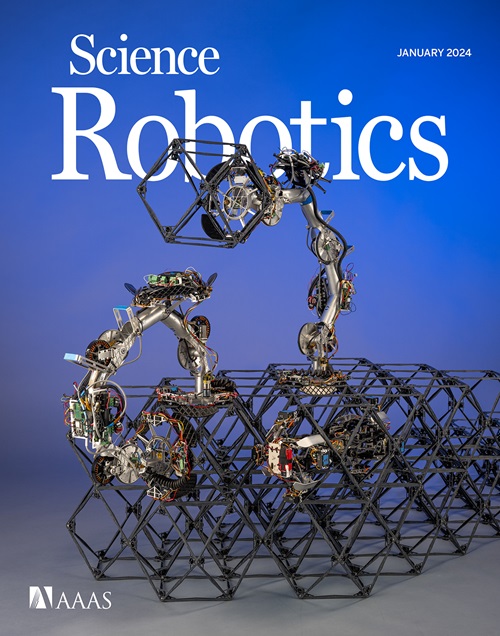AI search, physician removal: Bronchoscopy robot bridges collaboration in foreign body aspiration
IF 27.5
1区 计算机科学
Q1 ROBOTICS
引用次数: 0
Abstract
Bronchial foreign body aspiration is a life-threatening condition with a high incidence across diverse populations, requiring urgent diagnosis and treatment. However, the limited availability of skilled practitioners and advanced medical equipment in community clinics and underdeveloped regions underscores the broader challenges in emergency care. Here, we present a cost-effective robotic bronchoscope capable of computed tomography (CT)–free, artificial intelligence (AI)–driven foreign body search and doctor-collaborated removal over long distances via fifth-generation (5G) communication. The system is built around a low-cost (<5000 USD), portable (<2 kilograms) bronchoscope robotic platform equipped with a 3.3-millimeter-diameter catheter and 1-millimeter biopsy forceps designed for safe pulmonary search and foreign body removal. Our AI algorithm, which integrates classical data structures with modern machine learning techniques, enables thorough CT-free lung coverage. The tree structure is leveraged to memorize a compact exploration process and guide the decision-making. Both virtual and physical simulations demonstrate the system’s effective autonomous foreign body search, minimizing bronchial wall contact to reduce patient discomfort. In a remote procedure, a physician in Hangzhou successfully retrieved a foreign body from a live pig located 1500 kilometers away in Chengdu using 5G communication, highlighting effective collaboration of AI, robotics, and human experts. We anticipate that this 5G-enabled, low-cost, AI expert–collaborated robotic platform has notable potential to reduce medical disparities, enhance emergency care, improve patient outcomes, decrease physician workload, and streamline medical procedures through the automation of routine tasks.人工智能搜索,医生移除:支气管镜机器人在异物吸入方面的合作桥梁
支气管异物吸入是一种危及生命的疾病,在不同人群中发病率很高,需要紧急诊断和治疗。然而,在社区诊所和欠发达地区,熟练的从业人员和先进的医疗设备有限,这凸显了急诊护理面临的更广泛挑战。在这里,我们提出了一种具有成本效益的机器人支气管镜,能够通过第五代(5G)通信进行无计算机断层扫描(CT),人工智能(AI)驱动的异物搜索和医生合作的长距离清除。该系统是围绕一个低成本(5000美元)、便携式(2公斤)支气管镜机器人平台构建的,该平台配备了直径3.3毫米的导管和1毫米的活检钳,用于安全的肺部搜索和异物清除。我们的人工智能算法将经典数据结构与现代机器学习技术相结合,可以实现彻底的无ct肺部覆盖。利用树形结构来记忆紧凑的探索过程并指导决策。虚拟和物理模拟都证明了该系统有效的自主异物搜索,最大限度地减少了支气管壁接触,减少了患者的不适。在一次远程手术中,杭州的一名医生利用5G通信成功地从1500公里外的成都的一头活猪身上取出了异物,这突显了人工智能、机器人和人类专家的有效协作。我们预计,这种支持5g、低成本、人工智能专家协作的机器人平台在缩小医疗差距、加强紧急护理、改善患者治疗效果、减少医生工作量以及通过日常任务自动化简化医疗程序方面具有显著潜力。
本文章由计算机程序翻译,如有差异,请以英文原文为准。
求助全文
约1分钟内获得全文
求助全文
来源期刊

Science Robotics
Mathematics-Control and Optimization
CiteScore
30.60
自引率
2.80%
发文量
83
期刊介绍:
Science Robotics publishes original, peer-reviewed, science- or engineering-based research articles that advance the field of robotics. The journal also features editor-commissioned Reviews. An international team of academic editors holds Science Robotics articles to the same high-quality standard that is the hallmark of the Science family of journals.
Sub-topics include: actuators, advanced materials, artificial Intelligence, autonomous vehicles, bio-inspired design, exoskeletons, fabrication, field robotics, human-robot interaction, humanoids, industrial robotics, kinematics, machine learning, material science, medical technology, motion planning and control, micro- and nano-robotics, multi-robot control, sensors, service robotics, social and ethical issues, soft robotics, and space, planetary and undersea exploration.
 求助内容:
求助内容: 应助结果提醒方式:
应助结果提醒方式:


